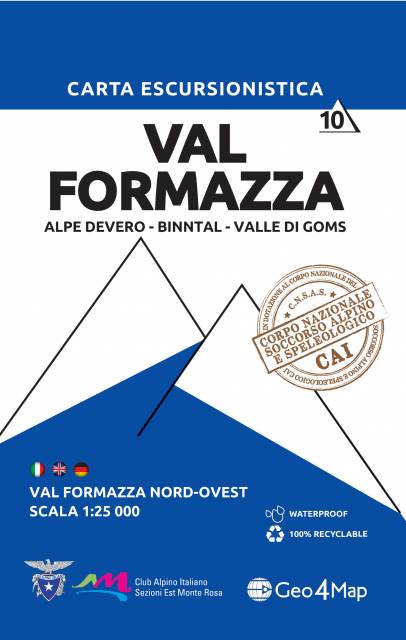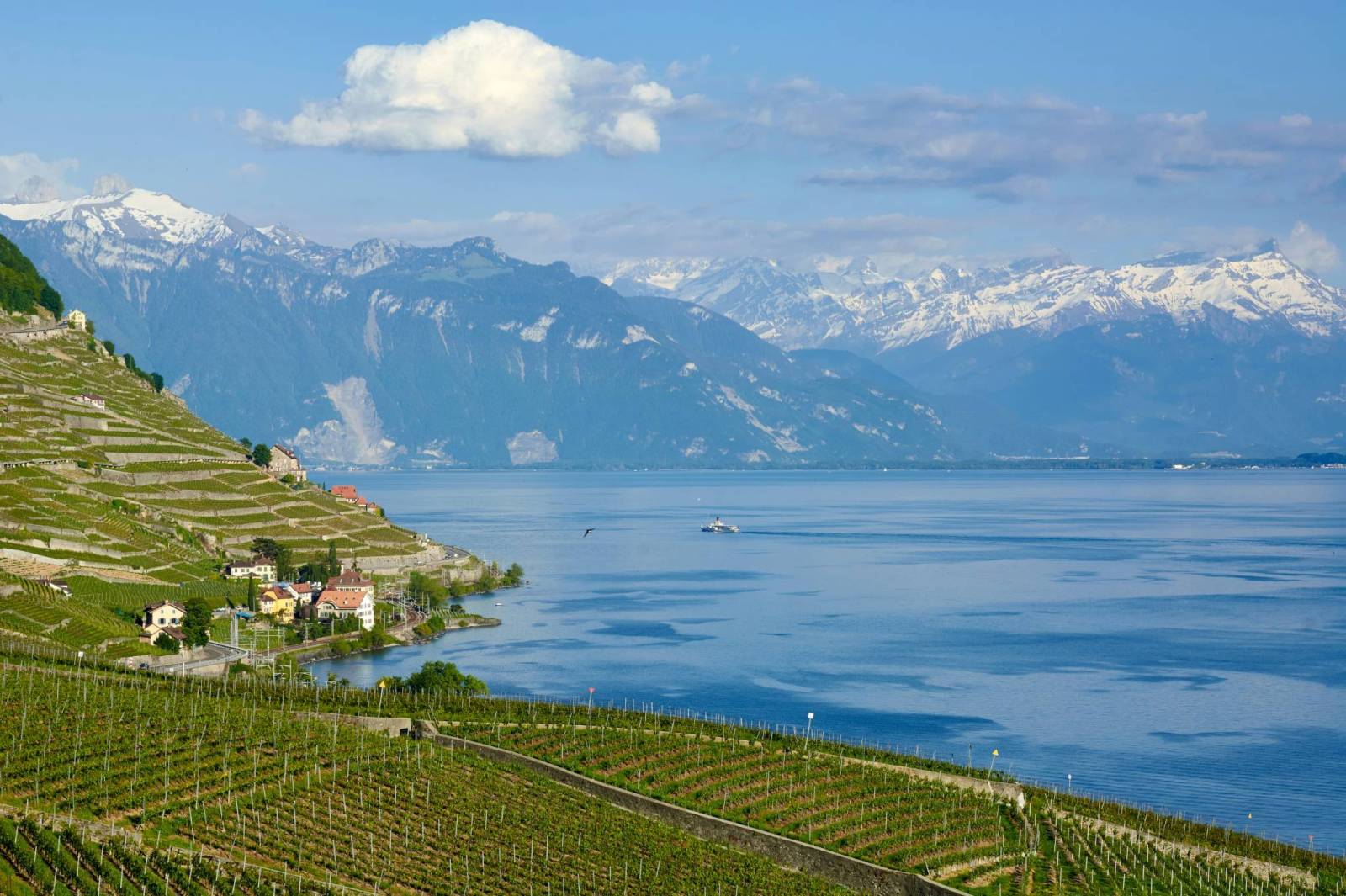Route map
The Seen-Route, or Swiss Veloroute 9, is one of the most beautiful cycle routes in Switzerland. It runs through the heart of the country, linking lakes, towns and spectacular scenery. On the stretch from Lausanne to Zurich, which is around 350 kilometres long, cyclists can expect not only perfectly prepared infrastructure, but also breathtaking views and cultural richness.
Route, attractions on the trail
The trail starts in Lausanne, a lively city located on Lake Geneva. Already at the start, it impresses with its location - steep hills descend towards the surface of the lake, and from almost every point you can see the Alps. Take a moment to visit the Olympic Museum, located right on the water's edge, and stroll through the historic centre with Notre Dame Cathedral and the atmospheric Escaliers du Marché staircase.
The route sets off from the town in a north-easterly direction, initially climbing gently uphill among the Lavaux vineyards, which are a UNESCO World Heritage Site. In the village of La Verrerie - set among the hills - the more alpine character of the trip begins. It's the perfect place for a first overnight stay or stopover. It is surrounded by extensive pastures, and the local cuisine-fondue and Gruyère cheese-is the perfect reward after a day of riding.
Definitely worth a stop in Rougemont, one of the most beautiful villages in the whole of Switzerland, located in the Pays-d'Enhaut valley. Just driving through Rougemont is like travelling back in time - the village is a veritable gallery of traditional wooden buildings. Centuries-old houses, some as old as 400 years, catch the eye with intricately carved or painted facades. Decorative elements often depict religious scenes, floral motifs, as well as the dates of construction and the initials of the former owners. All this is surrounded by well-tended gardens, balconies full of flowers and picturesque streets.
From the Fribourg region, the route climbs towards the Bernese Oberland, where the scenery becomes increasingly spectacular. Along the way, it is worth stopping at the Thunersee and Brienzersee lakes - one of Switzerland's most photogenic areas.
Spiez, located on Lake Thunersee, is one of the most beautiful Alpine towns. The castle on the hill overlooking the turquoise water and the majestic peaks of the Eiger, Mönch and Jungfrau in the background is a sight that is hard to forget. The surrounding area also offers well-maintained cycle paths and viewpoints.
After Spiez, the route passes through Interlaken, located between the lakes of Thun and Brienz - and then heads to Meiringen - known for the Reichenbach waterfall - it was here, according to Conan Doyle, that Sherlock Holmes died - and the beautiful Haslital valley.
A gem of the area, which is definitely worth including in your itinerary, is the Aare River Gorge (Aareschlucht) - one of the most extraordinary natural sites in all of Switzerland. This approximately 1,400-metre-long canyon, which is up to 200 metres deep and only one metre wide in places, has been carved by the swift current of the River Aare into the limestone rocks over the millennia.
From Meiringen, we descend down through Alpnach towards Lake Zugersee. This section of the route is much more physically gentle than the earlier, mountainous stages - it leads through green farmland, charming villages and well-maintained cycle paths along lakes and fields. Although technically easier, there is no shortage of places worth stopping at - and one of them, definitely unique, is Lucerne. This city is often regarded as the most beautiful in all of Switzerland. Just a short drive through its cobbled streets, full of history and perfectly preserved architecture, confirms this designation. It is worth planning a longer stop here to see the Chapel Bridge (Kapellbrücke), the Water Tower and the Mill Bridge (Spreuerbrücke), among others. The Wine Market, the Grain Market or the Glacier Garden are also worth a visit.
The final kilometres take you through Adliswil, a quiet district of Zurich amidst forests and villa estates. The Felsenegg cable car is worth climbing here, offering a spectacular view of the entire Lake Zurich.
The descent into Zurich is the perfect finale to this multi-day trip. We enter the city along the western shore of the lake, finally reaching the centre - with its historic old town, the Grossmünster and Fraumünster churches, the lively Bahnhofstrasse and the charming Limmat River.
Route signage
The trail is perfectly signposted. The entire route is marked with red number plates with the number 9 in the Veloland Schweiz system, allowing you to go virtually without a map.
Places to stay
The trail offers a wide range of cycle-friendly accommodation, from guesthouses to hotels. Recommended stops are: La Verrerie, Spiez, Meiringen, Zug or Baar.
Level of difficulty
The difficulty level of the route is moderate. It is ideal for people in good shape who are used to riding on varied terrain. There are more difficult alpine sections (e.g. Rougemont - Spiez - Meiringen), but much of the route follows gentle terrain and well-maintained cycle paths along the lakes.
Mapa trasy
Trasa rowerowa Seen-Route, czyli szwajcarska Veloroute 9, to jedna z najpiękniejszych tras rowerowych w kraju. Prowadzi przez serce Szwajcarii, łącząc jeziora, miasta i spektakularne krajobrazy. Na odcinku z Lozanny do Zurychu, który liczy około 350 kilometrów, rowerzyści mogą spodziewać się nie tylko doskonale przygotowanej infrastruktury, ale i zapierających dech w piersiach widoków oraz bogactwa kulturowego.
Przebieg trasy
Szlak rozpoczyna się w Lozannie, tętniącym życiem mieście położonym nad Jeziorem Genewskim. Już na starcie zachwyca położeniem — strome wzgórza opadają ku tafli jeziora, a z niemal każdego punktu widać Alpy. Warto poświęcić chwilę na zwiedzanie Muzeum Olimpijskiego, zlokalizowanego tuż nad brzegiem wody, a także na spacer po historycznym centrum z katedrą Notre Dame i klimatycznymi schodami Escaliers du Marché.
Trasa wyrusza z miasta w kierunku północno-wschodnim, początkowo łagodnie wspinając się w górę, wśród winnic Lavaux, które wpisane są na listę światowego dziedzictwa UNESCO.
W miejscowości La Verrerie — położonej wśród wzgórz — zaczyna się bardziej alpejski charakter wyprawy. To doskonałe miejsce na pierwszy nocleg lub przystanek. Otaczają ją rozległe pastwiska, a lokalna kuchnia-fondue i ser Gruyère to idealna nagroda po całym dniu jazdy.
Zdecydowanie warto zatrzymać się w Rougemont, jednej z najpiękniejszych wiosek w całej Szwajcarii, położonej w dolinie Pays-d’Enhaut.
Już sam przejazd przez Rougemont przypomina podróż w czasie – wioska to prawdziwa galeria tradycyjnej, drewnianej zabudowy. Wielowiekowe domy, niektóre liczące nawet 400 lat, przyciągają wzrok misternie rzeźbionymi lub malowanymi fasadami. Elementy zdobnicze często przedstawiają sceny religijne, motywy roślinne, a także daty budowy i inicjały dawnych właścicieli. Wszystko to otoczone jest zadbanymi ogrodami, balkonami pełnymi kwiatów i malowniczymi uliczkami.
Z regionu Fribourg trasa wspina się w kierunku Oberlandu Berneńskiego, gdzie krajobrazy stają się coraz bardziej spektakularne. Po drodze warto zatrzymać się nad jeziorami Thunersee i Brienzersee — jednym z najbardziej fotogenicznych rejonów Szwajcarii.
Spiez położone nad jeziorem Thunersee to jedno z najpiękniejszych alpejskich miasteczek. Zamek na wzgórzu z widokiem na turkusową wodę i majestatyczne szczyty Eiger, Mönch i Jungfrau w tle to widok, który trudno zapomnieć. Okolica oferuje też świetnie utrzymane ścieżki rowerowe i punkty widokowe.
Za Spiez trasa prowadzi przez Interlaken, położone między jeziorami Thun i Brienz- a następnie kieruje się do Meiringen — znanego z wodospadu Reichenbach- to właśnie tutaj według Conana Doyle’a zginął Sherlock Holmes, oraz z przepięknej doliny Haslital.
Perłą okolicy, którą zdecydowanie warto uwzględnić w planie podróży, jest Wąwóz rzeki Aare (Aareschlucht) – jedno z najbardziej niezwykłych miejsc naturalnych w całej Szwajcarii. Ten około 1400-metrowy kanion, o głębokości sięgającej 200 metrów i miejscami zaledwie metr szerokości, został przez tysiąclecia wyrzeźbiony przez wartki nurt rzeki Aare w wapiennych skałach.
Z Meiringen zjeżdżamy w dół przez Alpnach w kierunku jeziora Zugersee. Ten odcinek trasy jest znacznie łagodniejszy fizycznie niż wcześniejsze, górskie etapy – prowadzi przez zielone tereny rolnicze, urocze wsie i dobrze utrzymane ścieżki rowerowe wzdłuż jezior i pól. Choć łatwiejszy technicznie, nie brakuje tu miejsc wartych zatrzymania się – a jednym z nich, zdecydowanie wyjątkowym, jest Lucerna. Miasto to często uznawane jest za najpiękniejsze w całej Szwajcarii. Już krótki przejazd przez jego brukowane uliczki, pełne historii i doskonale zachowanej architektury, potwierdza to miano. Warto tu zaplanować dłuższy postój, by zobaczyć m.in. Most Kapliczny (Kapellbrücke), Wieżę Wodną, Most Młyński (Spreuerbrücke). Warto odwiedzić także Rynek Wina, Rynek Zbożowy czy też Ogród Lodowcowy.
Ostatnie kilometry prowadzą przez Adliswil, spokojną dzielnicę Zurychu wśród lasów i willowych osiedli. Warto tutaj wspiąć się kolejką linową Felsenegg, skąd rozciąga się spektakularny widok na całe jezioro Zuryskie.
Zjazd do Zurychu to doskonały finał tej wielodniowej wyprawy. Wjeżdżamy do miasta wzdłuż zachodniego brzegu jeziora, docierając w końcu do centrum — z jego historycznym starym miastem, kościołami Grossmünster i Fraumünster, tętniącą życiem Bahnhofstrasse i urokliwą rzeką Limmat.
Oznakowanie trasy
Szlak jest doskonale oznakowany. Cała trasa jest oznaczona czerwonymi tabliczkami z numerem 9 w systemie Veloland Schweiz, co pozwala jechać praktycznie bez mapy.
Miejsca noclegowe
Szlak oferuje szeroką gamę miejsc noclegowych przyjaznych rowerzystom, od pensjonatów po hotele. Polecane przystank toi: La Verrerie, Spiez, Meiringen, Zug lub Baar.
Poziom trudności
Poziom trudności trasy jest umiarkowany. Idealny dla osób z dobrą kondycją, przyzwyczajonych do jazdy po zróżnicowanym terenie. Trudniejsze są odcinki alpejskie (np. Rougemont – Spiez – Meiringen), ale duża część trasy prowadzi po łagodnych terenach i dobrze utrzymanych drogach rowerowych wzdłuż jezior.









